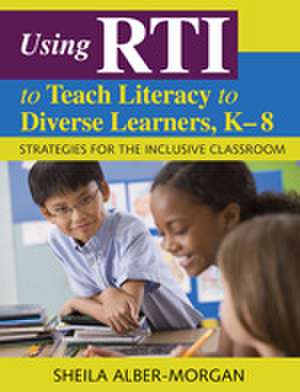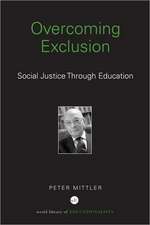Using RTI to Teach Literacy to Diverse Learners, K-8: Strategies for the Inclusive Classroom
Autor Sheila Alber-Morganen Limba Engleză Paperback – 7 iun 2010
Using RTI to Teach Literacy to Diverse Learners, K-8 is an ideal working tool that allows teachers to read about and immediately implement the author's instructional procedures for reading and writing in their own classrooms.
Preț: 283.58 lei
Nou
54.27€ • 56.34$ • 45.25£
Carte tipărită la comandă
Livrare economică 25 martie-08 aprilie
Specificații
ISBN-10: 1412969522
Pagini: 152
Dimensiuni: 216 x 279 x 10 mm
Greutate: 0.43 kg
Ediția:1
Editura: SAGE Publications
Colecția Corwin
Locul publicării:Thousand Oaks, United States
Recenzii
"Sheila Alber-Morgan has written an information-rich book that teachers will find clearly written, interesting, and remarkably helpful for assessing and implementing literacy interventions in inclusive classrooms."
"In a small volume, Sheila Alber-Morgan addresses RTI in a much more comprehensive way than other texts. The book provides critical features of RTI across reading, writing, handwriting, and spelling. Each area is supported by strategies for assessment and multi-tiered instruction grounded in basic principles of applied behavior analysis, UDL, generalization, and inclusion. It is packed with practical information for each tier and many references for greater elaboration."
"By placing scientifically based assessment and instruction into the RTI context, the author offers readers an opportunity to select practices in accordance with student needs, their responsiveness to instruction, and existing federal and state mandates. The text comes with easy-to understand graphics, practical applications, and numerous instructional resources. This book can be used with preservice and inservice teachers and as a primary text in teacher education courses. The assessment and instructional strategies provided have strong empirical support that meets educators’ needs now and in years to come."
"Alber-Morgan clearly and concisely articulates the theoretical and empirical bases of RTI—an important and worthy achievement. For the classroom teacher, her book provides numerous assessment and instructional strategies for turning the great promise of RTI into reality for students. The book outlines five powerful strategies for increasing the likelihood that students will remember and later use the literacy skills they have learned. Each strategy for programming generalization is then fleshed out with specific examples at the tactical level."
Cuprins
About the Author
1. Overview
Universal Design and Response to Intervention
Diverse Learners and Inclusive Classrooms
NCLB and Evidence-Based Practices
Special Education Law
RTI and Assessment
Curriculum-Based Measurement
RTI and Literacy Instruction
Explicit Instruction and Active Student Responding
Peer-Mediated Instruction
Integrating Language Arts
Programming for Generalization
Collaborative Teaching
Summary
2. Assessing for Intervention in Reading
RTI and CBM reading
CBM Reading Methods
Oral Reading Fluency
CBM Maze
CBM Early Reading
Vocabulary Matching
Miscue Analysis and Comprehension Checks
Authentic Assessment
Summary
Maya
3. Implementing Multi-Tiered Reading Instruction
Evidence-Based Practices
Reading Instruction: Tier 1
Reading Instruction: Tiers 2 & 3
Phonemic Awareness: Tier 1
Phonemic Awareness: Tiers 2 & 3
Alphabetics: Tier 1
Alphabetics: Tiers 2 & 3
Fluency: Tier 1
Fluency: Tiers 2 & 3
Vocabulary: Tier 1
Vocabulary: Tiers 2 & 3
Comprehension: Tier 1
Comprehension: Tiers 2 & 3
Summary
Alexei
4. Assessing for Intervention in Writing
RTI and Writing Assessment
CBM Writing Measures
Managing CBM Writing
Writing Rubrics
Portfolios
Summary
Dylan
5. Implementing Multi-Tiered Writing Instruction
Evidence-Based Practices
Handwriting Instruction: Tier 1
Handwriting Instruction: Tiers 2 & 3
Keyboarding Instruction
Spelling Instruction: Tier 1
Spelling Instruction: Tiers 2 & 3
Writing Process: Tier 1
Writing Process: Tiers 2 & 3
Computer Technology for Writing: Tier 1
Computer Technology for Writing: Tiers 2 & 3
Summary
Carmen
6. Using Thematic Units to Integrate the Language Arts
Creating Thematic Units for Multi-Tiered Instruction
Selecting a Theme
Identifying and Obtaining Resources and Materials
Identifying Language Arts Skills
Planning Multi-Tiered Instruction
Summary
7. Programming for Generalization of Literacy Skills
Selecting Representative Teaching Examples
Making the Classroom Resemble Generalization Settings
Providing Students with a Means to Access Reinforcement
Arranging Ways to Transfer Skills to Different Settings
Training Students to Transfer Skills
8. Closing the Research to Practice Gap
References
Index
Notă biografică
Sheila Alber-Morgan has been an associate professor of special education at The Ohio State University since 2005. She was also a faculty member at The University of Southern Mississippi for eight years. After teaching for several years in inclusive classrooms in both urban and rural South Carolina, Dr. Alber-Morgan began doctoral training at The Ohio State University and earned her Ph.D. in 1997. For the past 15 years, Dr. Alber-Morgan¿s research has focused on examining the effects of various literacy interventions on the learning outcomes of elementary and secondary students with and without disabilities. Additionally, her research incorporates strategies for programming for generalization and maintenance of academic and social skills. Almost all of Dr. Alber-Morgan¿s research has been designed and implemented in collaboration with classroom teachers, and she has over 50 research and practitioner publications including peer reviewed journal articles, textbook ancillaries, and book chapters.













